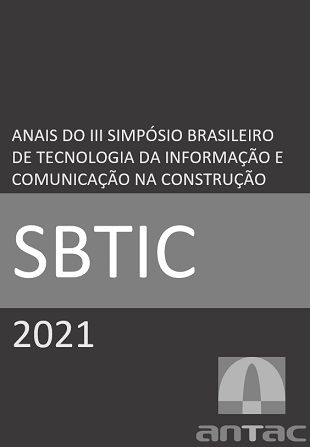Ensaio de interoperabilidade entre Revit® e Archicad®: arquitetura e hidrossanitário associados
DOI:
https://doi.org/10.46421/sbtic.v3i00.627Palavras-chave:
Interoperabilidade, Compatibilidade, Detecção de conflito, Arquitetura, HidrossanitárioResumo
A partir dos anos 2000, as noções de interoperabilidade e compatibilidade ganharam uma semântica contundente, principalmente em função da reunião de novas disciplinas nos ambientes de projeto. Em virtude disso, a fim de explorar os limites atuais das camadas de integração, apresentam-se, neste artigo, testes utilizando padrões neutros e ferramentas nativas de aplicativos de modelagem, as quais, por sua vez, são suficientes para trocas simples de informação. A partir dos resultados, construíram-se inferências, respeitando o caráter qualitativo e sem pretensões de generalização, sobre a associação dos projetos de arquitetura e hidrossanitário, exprimindo o atual distanciamento da plena interoperabilidade.
Downloads
Referências
AFSARI, K.; EASTMAN, C.; SHELDEN, D. Building Information Modelling data interoperability for Cloud-based collab9oration: Limitations and Opportunities. International Journal of Architectural Computing, v. 15, n. 3, p. 187-202, Set 2017. DOI: https://doi.org/10.1177/1478077117731174.
ARAYICI, Y. et al. Interoperability specification development for integrated BIM use in performance based design. Automation in Construction, v. 85, p. 167-181, jan. 2018. DOI: https://doi.org/10.1016/j.autcon.2017.10.018.
CHEN, Q. et al. Robust IFC files to improve information exchange: An application for thermal energy simulation. In: INTERNATIONAL STRUCTURAL ENGINEERING AND CONSTRUCTION CONFERENCE, 9., 2017, Valencia. Proceedings […]. Valencia: ISEC Press. 2017. DOI: https://doi.org/10.14455/isec.res.2017.8.
CHIAIA, B. et al. BIM and interoperability for energy simulations. In: BUILDING SIMULATION APPLICATIONS, 2., 2015, Bolzano. Proceedings […]. Bolzano: bu,press. 2015. p. 93-97.
DICIO. Dicionário Online de Português. Disponivel em: https://www.dicio.com.br/. Acesso em: 10 fevereiro 2021.
EASTMAN, C. et al. BIM Handbook: A guide to building information modelling for owners, managers, designers, engeneers and contractores. 2. ed. Nova Iorque: John Wiley & Sons, 2011.
EISENMAN, P. Visions unfolding: architecture in the age of electronic media. In: NESBITT, K. Theorizing a New Agenda for Architecture. 2. ed. Nova Jersey: Princeton Architectural Press, 1996. p. 556-561.
GOLABCHI, A.; KAMAT, V. R. Evaluation of Industry Foundation Classes for Practical Building Information Modeling Interoperability. In: INTERNATIONAL SYMPOSIUM ON AUTOMATION AND ROBOTICS IN CONSTRUCTION AND MINING, 30., 2013, Montreal. Proceedings […]. Montreal: IAARC. 2013. p. 17-26. DOI: https://doi.org/10.22260/isarc2013/0003.
GROAT, L.; WANG, D. Architectural research methods. 2. ed. Nova Iorque: Wiley, 2013.
INTERNATIONAL ORGANIZATION FOR STANDARDIZATION. ISO 16739-1:2018: Industry Foundation Classes (IFC) for data sharing in the construction and facility management industries — Part 1: Data schema. 1 ed. 2018. 1474p. Disponível em: https://www.iso.org/standard/51622.html. Acesso em: 17 fevereiro 2021.
KARTIKEAYAN, R. S.; SALMALIZA, S.; RASHID, Y. Building Information Modeling Interoperability Issues. International Journal of Computer Sciences and Engineering, v. 5, n. 5, p. 7-19, Mai 2017.
KOLAREVIC , B.; MALKAWI, A. Peformative Architecture: Beyond Instrumentality. Nova Iorque: Spon Press, 2005.
LAAKSO, M.; KIVINIEMI, A. The IFC standard - A review of history, development, and standardization. Electronic Journal of Information Technology in Construction, v. 17, p. 134-161. Maio 2012.
MASTINO, C. C. et al. The building information model and the IFC standard: Analysis of the characteristics necessary for the acoustic and energy simulation of buildings. In: BUILDING SIMULATION APPLICATIONS, 3., 2017, Bolzano. Proceedings […]. Bolzano: bu,press. 2017. p. 479-486.
MOORE, R.; MCAULEY, B.; HORE, A. The application of industry standards as an alternative to in-house proprietary standards within the AEC industry. In: CITA BIM GATHERING, 2., 2015, Dublin. Proceddings […]. Dublin: CitA. 2015. p. 86-93. DOI: https://doi.org/10.21427/pxea-a115.
OZTURK, G. Interoperability in building information modeling for AECO/FM industry. Automation in Construction, v. 113, mai. 2020. DOI: https://doi.org/10.1016/j.autcon.2020.103122.
SILVA, T. et al. Design synthesis and performance: simulation, discussion and generative strategies. In: CONGRESO DA SOCIEDADE IBEROAMERICANA DE GRÁFICA DIGITAL, 22., 2018, São Carlos. Proceedings [...]. São Paulo: Blucher. 2018. p. 625-630. DOI: https://doi.org/10.5151/sigradi2018-1824.
Publicado
Como Citar
Edição
Seção
Licença
Copyright (c) 2021 SIMPÓSIO BRASILEIRO DE TECNOLOGIA DA INFORMAÇÃO E COMUNICAÇÃO NA CONSTRUÇÃO

Este trabalho está licenciado sob uma licença Creative Commons Attribution 4.0 International License.
Adota-se Atribuição 4.0 Internacional (CC BY 4.0). Ver detalhamento em https://creativecommons.org/licenses/by/4.0/deed.pt_BR

